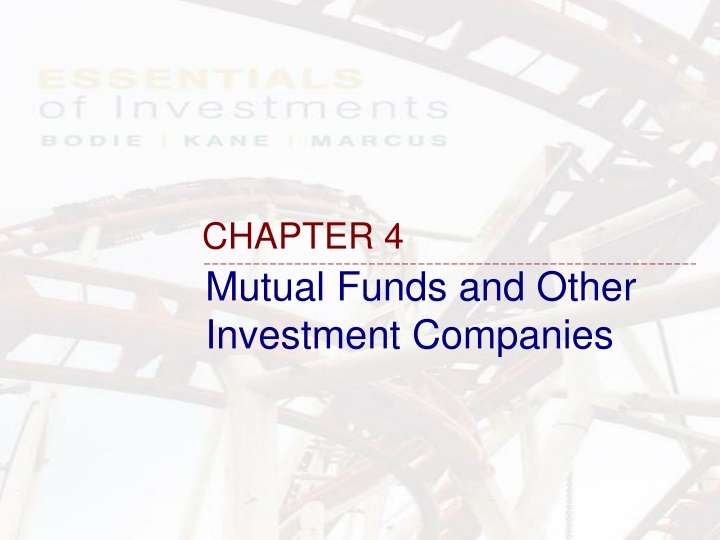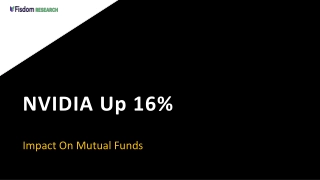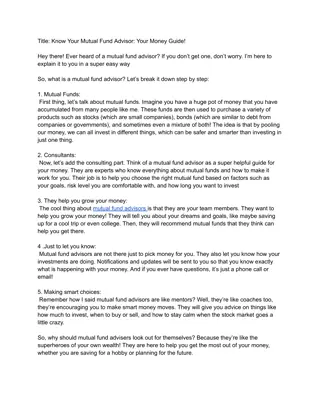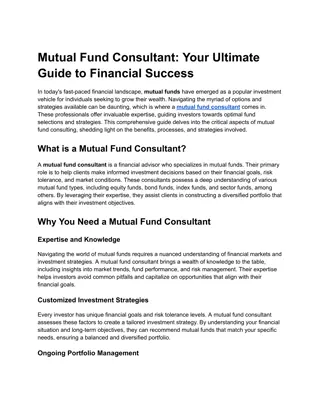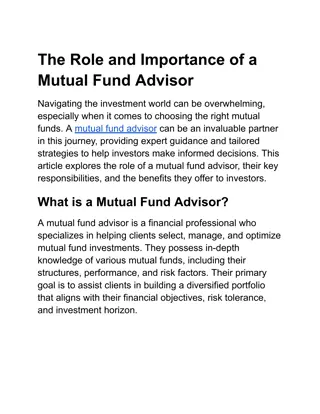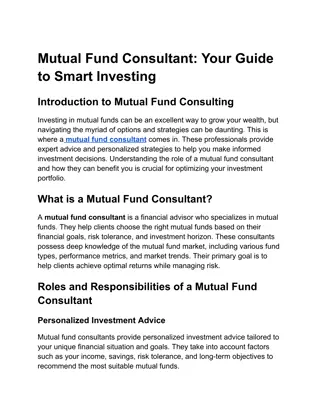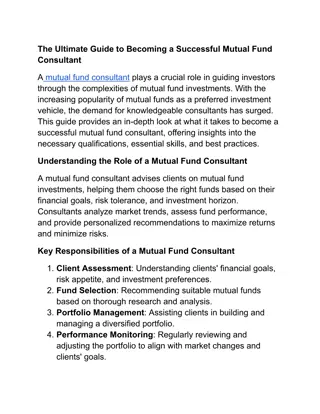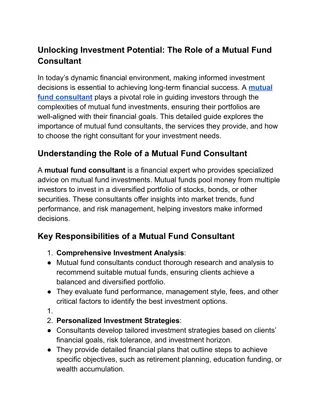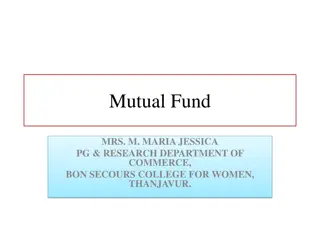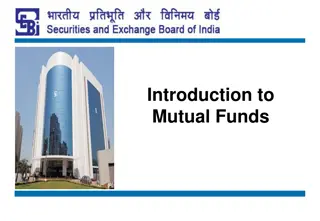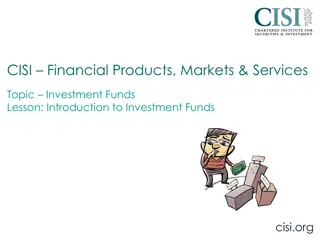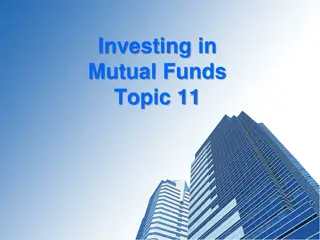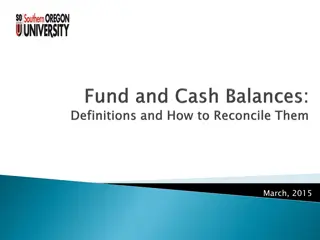Mutual Funds and Investment Companies: Functions and Types
An insight into investment companies, mutual funds, and exchange-traded funds. Learn about the functions of investment companies, different types of mutual funds, costs associated with investing in mutual funds, and the performance of mutual funds. Understand how investment companies pool assets from investors, achieve diversification, provide professional management, and lower transaction costs.
Download Presentation

Please find below an Image/Link to download the presentation.
The content on the website is provided AS IS for your information and personal use only. It may not be sold, licensed, or shared on other websites without obtaining consent from the author.If you encounter any issues during the download, it is possible that the publisher has removed the file from their server.
You are allowed to download the files provided on this website for personal or commercial use, subject to the condition that they are used lawfully. All files are the property of their respective owners.
The content on the website is provided AS IS for your information and personal use only. It may not be sold, licensed, or shared on other websites without obtaining consent from the author.
E N D
Presentation Transcript
CHAPTER 4 Mutual Funds and Other Investment Companies
Learning Goals of Chapter 4 Introduce investment companies ( ) Functions and different types: unit investment trusts, managed investment companies, other investment organizations Introduce various kinds of mutual funds ( ), which are the dominant type of investment companies Discuss the costs and taxes of investing in mutual funds Introduce exchange-traded funds (ETFs) ( ) Performance of mutual funds: a first look 4-2
Investment Companies An investment company ( ) collects money from investors and invest the proceeds in a portfolio of securities on behalf of those investors While investment companies pool the assets for investors, they also sell investors shares, which represent the ownership on this pool of assets Investment companies are financial intermediaries Investment companies trade on behalf of their shareholders rather than for their own account The net effect of the investment company is to channel household savings to business sectors Existence reason: they provide a mechanism for small investors to team up to obtain the benefits of large-scale investment 4-4
Investment Companies The investment company is in essence a legal arrangement for a fund ( ), i.e., you can treat each fund as an investment company ( ) Four major functions of investment companies 1. Administration and record keeping Keep track of the position and any income of the portfolio as well as each shareholder Send periodic status reports to shareholders Reinvest dividends and interest incomes on behalf of shareholders 4-5
Investment Companies 2. Achieve diversification ( ) and avoid indivisible problem ( ) By polling individual investors money, the investment companies can act as large investors, that is, they can invest in a well-diversified portfolio and avoid the indivisible problem of the stock share 3. Professional management Hire security analysts and fund managers to achieve superior investment results for their investors Find undervalued securities and/or design asset allocation strategies Share research and management costs 4. Lower transaction costs Due to block trading of securities, investment companies could save substantial brokerage fees or bid-asked spreads 4-6
Investment Companies: Net Asset Value Net Asset Value (NAV) ( ) A quantity to measure the share value (or said net worth per share) of an investment company (or a fund) Definition: Market value of assets Liabilities Number of outstanding shares Similar to calculating the net worth of each stock share 4-7
Types of Investment Companies In the U.S., the investment companies are classified as either unit investment trusts or managed investment companies Unit Investment Trusts ( ) Money pooled from investors is invested in a fixed (unmanaged) portfolio with relatively uniform types of assets, e.g., municipal bonds, for the life of the fund Originators buy a portfolio deposited into a trust and sells units in the trust, called redeemable trust certificates ( ), at a premium to investors Any interest and/or dividends are distributed immediately to trust certificate holders Often use leverage to amplify rates of return This arrangement loses its market share continuously 4-9
Types of Investment Companies Managed Investment Companies ( ) Managed investment companies are so named since securities in their portfolios are continuously bought and sold, i.e., the portfolios are managed The fund (managed investment company) hires a management company ( ) to manage the portfolio for an annual fee ranging from 0.2% to 1.5% of assets The management company is usually the firm that originated the fund One management company can have contracts to manage several funds The famous management companies include Fidelity ( ), Vanguard, Putnam, and Dreyfus 4-10
Types of Investment Companies Two types of managed investment companies: closed-end funds and open-end funds Open-End Funds ( ) (discussed in Section 4.3) Redeem ( ) or issue ( ) shares at NAV, and the investment company guarantees the trading liquidity of shares The number of outstanding shares changes when new shares are sold or old shares are redeemed (funds are easy to grow) Open-end funds are what we call mutual funds ( ) Disadv.: need to keep cash reserves and vulnerable to panics Closed-End Funds ( ) Shares of closed-end funds are traded like other stock shares on exchanges (e.g., day-trading ( ) is allowed) Shares are not redeemed by the closed-end funds, so investors in closed-end funds who wish to cash in must sell their shares to other investors (the fund itself is not involved) The number of outstanding shares does not change unless new shares are offered 4-11
Types of Investment Companies The market price is determined by the demand and supply, so the premia ( ) or discounts ( ) versus the NAV reflect the market consensus about the expected performance of closed-end funds However, the market price should not deviate from NAV because if a closed-end fund were to be liquidated ( ) immediately, the shareholders would receive exactly the proceeds equal to NAV So, the divergence of market price from NAV is a puzzle that has not yet to be fully explained Some studies (Thompson (1978) and Pontiff (1995)) believe that on average, price premia or discounts tend to disappear over time, but it is still common to see that the deviations (especially the discounts) persist for long periods of time 4-12
Types of Investment Companies Other Investment Organizations They are not formally organized as investment companies but serve similar functions as investment companies Commingled funds ( ) Commingled funds are partnerships ( ) of investors that pool their funds (not in corporation form) Typical partners in a commingled fund might be trusts or large retirement accounts, which are larger than the asset of most individual investors but are still too small to be managed separately Commingled funds are operated similar to open-end funds, but instead of shares, the funds offer units Different types of commingled funds, e.g., money market or common stock commingled funds 4-13
Types of Investment Companies Real Estate Investment Trusts (REITs) ( ) REITs, similar to closed-end funds, invest in real estate or loans secured by real estate Two categories of REITs: Equity trusts ( ) invest in real estate directly, e.g., shopping malls, office buildings, hotels, etc. Mortgage trusts ( ) invest in mortgage loans and mortgage-back securities In addition to issuing shares, REITs also raise funds through borrowing money from banks or issuing bonds to increase the leverage (typical debt ratio of 70%) and thus amplify the returns for shareholders REITs are exempt from corporate taxes as long as at least 90% of their taxable income is distributed to shareholders annually in the form of dividends 4-14
Types of Investment Companies Hedge Funds ( ) An investment pool, which is open only to wealthy or institutional investors, is commonly structured as a PRIVATE partnership ( ) to escape from SEC regulations and therefore pursue more speculative policies than mutual funds Hedge funds can employ strategies that are not allowed for mutual funds, for example, heavy use of derivatives, short sales, high level of leverage, etc. Grew rapidly in the past several years, from $50 billion in 1990 to over $5 trillion in 2023 Hedge funds commonly attempt to exploit temporary misalignments between the values of securities in different markets, so they usually buy one type of asset and sell another simultaneously 4-15
Types of Investment Companies Example 1: if the ratio between the prices of ADR and share of TSMC is too high, buy 5 shares of TSMC and short 1 share of ADR of TSMC, and when the ratio becomes normal, sell 5 shares of TSMC and buy back 1 share of ADR of TSMC Example 2: if the yield spread between MBS and T-Bonds is abnormally wide, buy MBS and short sell T-Bonds, and when the spread narrows back to the normal level, close out the position by selling MBS and buying back T-Bonds Analyses of the above two strategies: Hedge funds care about the relative values of two securities with a common risk factor, e.g., interest rates or share prices Hedge funds DO NOT BET on the trend in the common risk factor, so the above strategies are designed to earn profits regardless of the movement of the common risk factor For equity funds, the annual fee is about 1% to 1.5%, but for hedge funds, annual fee may be 2% plus a bonus, which is a substantial fraction of any investment profits, typically 20% 4-16
4.3 MUTUAL FUNDS 4-17
Types of Mutual Funds Mutual fund ( ) is the common name for an open-end investment company ( ) This is the dominant type of investment company in the U.S. today, accounting for more than 90% of investment company assets Different types of mutual funds can be classified by their investment targets and investment policies Money market funds, Equity funds, Specialized sector funds, Bond funds, International funds, Balance funds, Asset allocation funds, and Indexed funds 4-18
Types of Mutual Funds Money market funds (MMFs) ( ) Invest in money market instruments (MMIs) including T-bills, CPs, RPs, CDs, etc. MMFs maintain a stable $1 NAV Holding MMIs to maturity generates no capital gains MMFs distribute all interest incomes to shareholders As long as there is no default, the NAV is fixed at $1 Thus, there is no capital gain tax associated with trading shares of MMFs (always trading at $1) Existence reason: Earn more than depositing in bank accounts with little additional risk U.S. regulations for controlling risks of MMFs: Restricted to invest in money market instruments that mature in 13 months Maintain a weighted average maturity of 90 days or less Invest less than 5% in any one issuer, except for government securities and RPs 4-19
Types of Mutual Funds Equity funds ( ) Invest primarily in stock shares About 5% assets are in money market securities to provide the liquidity to meet potential redemption Income funds ( ) or tend to hold stocks with high dividends, also known as value stocks Growth funds ( ) focus on prospects for capital gains Growth stocks and therefore growth funds are riskier and more sensitive to the business cycle Specialized sector funds ( ) One kind of equity funds, but concentrate on a particular industry such as biotechnology, utilities, precious metal, or telecommunications, etc. 4-20
Types of Mutual Funds Bond funds or Fixed income funds ( ) These funds specialize in the fixed-income sector Possibly concentrate on corporate bonds, T-bonds, mortgage-backed securities, or municipal bonds Or could be classified according to different maturities (from short-term to long-term) or different credit ratings (from very safe to high-yield bonds) International funds ( ) International funds (excluding the U.S.), global funds (worldwide, including the U.S.), regional funds (particular region), and emerging market funds ( ) (developing countries) Achieve further diversification but incur foreign exchange risk ( ) 4-21
Types of Mutual Funds Balanced funds ( ) These funds hold both equities and fixed-income securities in relatively stable proportions Life-cycle funds ( ): A series of funds whose asset mix ranges from aggressive (for young investors) to conservative (for old investors) Targeted-maturity funds ( ) gradually become more conservative as approaching the targeted date Can be candidates for individual investors entire investment portfolio Many balanced funds are in fact funds of funds ( ), i.e., they primarily invest in shares of other equity and bond mutual funds 4-22
Types of Mutual Funds Asset allocation of Flexible funds ( ) Similar to balanced funds, but the proportions allocated to each market may change dynamically according to manager s forecast of the relative performance of each market Increase equity investments in a boom and increase bond investments in a recession This funds engage in the market timing strategy essentially and cannot be viewed as low-risk investment vehicles like balanced funds 4-23
Types of Mutual Funds Index funds ( ) An index fund tries to replicate the performance of a broad market index For example, the Vanguard 500 Index Fund is a mutual fund that replicate the composition of the Standard & Poor s 500 stock index Because the S&P 500 is a market value-weighted index, the manager should invest funds in S&P 500 companies in proportion to their market values of outstanding equity shares Investment in an index fund is a low-cost way for small investors to pursue a passive investment strategy, i.e., to invest without security analysis and enjoy the benefit of diversification 4-24
4.4 COSTS OF INVESTING IN MUTUAL FUNDS 4-26
Fee Structure Operating expenses ( ) Include administrative expenses and advisory fees paid to the investment manager For book keeping or periodic reports preparation For managed portfolios: not only pursue higher expected returns but also maintain the liquidity of the fund such that shareholders can always sell the shares back to the fund Deducted from the assets of fund periodically, so shareholders do not receive explicit bills 0.2%-2% annually 4-27
Fee Structure Front-end load ( ) A front-end load is a sales charge paid when you purchase the shares (primarily paying commission fees to brokers who market the fund) 0%-8.5% one-time charge Rarely higher than 6% Usually inversely related with the size of investment ( ) Front-end loads will reduce the amount of money invested. For example, each $1,000 paid for a fund with a 6% load results in a sales charge of $60 and investment fund of only $940 4-28
Fee Structure Back-end load ( ) A back-end load (deferred sales charge or exit fee) is paid when fund shares are sold (goes to brokers who market the fund's shares) Typically, the fee structure is designed such that investors need to pay either the front-end load or the back-end load (see examples on Slide 4-31) The rate of back-end load depends on the number of years for holding shares It usually starts at 4% or 5% and reduces by one percentage for every following year This is because the decision of the level of the back- end load is usually bundled with the decision on annual commissions in 12b-1 fees (introduced next) 4-29
Fee Structure 12b-1 charges SEC rule 12b-1 allows the managers of funds to use fund assets to pay 1.Distribution/Marketing expense ( ) (0.75% per year max): including commissions ( ) paid to brokers who sell fund shares to investors or marketing costs ( ) such as advertising or distributing promotional literature (By marketing a mutual fund, its assets would increase and management could lower expenses because of economies of scale) 2.Service expense ( ) (0.25% per year max), e.g., the costs of employing people to respond to investor queries or dealing with legal issues Similar to operating expenses, 12b-1 fees are deducted from the fund assets and shareholders do not receive explicit bills for 12b-1 fees 4-30
Various Classes of Fee Structures Choice from different combinations of fees Class A Class B Class C Class I Front-end load 4.5% 0 0 0 Back-end load 0 0-4% 1% 0 12b-1 fees 0.25% 1% 1% 0 Expense ratio 0.7% 0.7% 0.7% 0.7% Class I shares are sold to institutional investors Individual investors pay either the front-end load or the back-end load The back-end load is usually coupled with the annual commissions of 0.75% in 12b-1 fees. Since these commissions are paid to brokers annually, the back- end load that brokers can receive decreases gradually in the following years If an investor choose the fee structure of Class B and intend to invest for about 6-8 years, the shares may convert into Class A shares with lower 12b-1 fees (Class C shareholders do not have this option) The expected investment horizon is the key factor to choose between one-time charges and annual effective expense ratios (see Slide 4-33) 4-31
Fees and Mutual Fund Returns: An Example Initial NAV = $20 Income distributions of $.15 Capital gain distributions of $.05 Ending NAV = $20.10 (this value has already reflected the annual deduction of the expenses and 12b-1 fees) Note that this measure of the rate of return ignores load expenses 4-32
Impacts of Costs on Investment Performance By comparing the performance of Fund B and Fund C for 20 years, you can find that different structures of fees will affect your return, especially for a long investment horizon 4-33
Fee Structure Soft dollar arrangement A portfolio manager earns soft-dollar credit with a broker by directing the fund s trades to that broker Based on those credits, the broker will pay for some of the mutual fund s expenses, such as databases, computer hardware, stock-quotation system, or stock research reports (which are purchased by half of funds) This arrangement is allowed by SEC as long as the soft dollars are used to purchase something ultimately benefiting the shareholder of funds Brokers effectively return part of the trading commission to funds With soft-dollar arrangement, funds may report artificially low expense ratios to the public Funds may pay needlessly high commission to obtain soft dollars Even with the low reported expense ratio, the high commission fees still hurt the investment performance 4-34
4.5 TAXATION OF MUTUAL FUND INCOME 4-35
Taxation of Mutual Fund Income A fund s capital gains and dividends are all passed to investors as if the investor earned the income directly, so taxes are actually paid by the investors in the mutual fund, not by the fund itself A fund with a high turnover rate ( ) leads to tax inefficiency Turnover rate: the ratio of the trading activity for a portfolio to the total asset value of that portfolio. For example, a $100 million portfolio with $60 million in sales of some securities with purchase of other securities would have a turnover rate of 60% For equity and index funds, the one-year average turnover rates are 50% and 2%, respectively 4-36
Taxation of Mutual Fund Income High turnover means there are often realized capital gains which may be taxed (as long as the capital gains are not realized, they are not taxed) Higher turnover rates also imply more commission costs of funds for trading securities SEC requires funds to disclose after-tax returns for the past 1-, 5-, and 10-year periods Personally managed portfolios can be structured to take advantage of taxes while mutual funds cannot The investor can time realizations of capital gains or losses to efficiently manage his whole tax liability (If the taxable income is high, the investor can decide to realize less capital gain such that the total tax payment can be controlled) 4-37
Exchange Traded Funds ETFs are offshoots ( ) of mutual funds that allow investors to trade some shares of entire portfolios ETFs were first offered in the U.S. in 1993 and, until 2008, were traded exclusively on market indexes By 2022, more than 2,500 ETFS with $7.2 trillion in assets in the U.S. ETFs tend to be open-end funds, but they can be traded like stock shares (a characteristic of closed- end funds) The size of an ETF could change, so it is an open-end fund Unlike mutual funds, ETFs trade throughout the day similar to stocks, whereas mutual funds are only traded at their NAV at the end of the day 4-39
Exchange Traded Funds A ETF offers security shares, replicating (or tracking) the return of an index, that can be traded like other stock shares on an exchange Replicate ( ): ETFs invest their assets proportionately in all securities underlying an index Track ( ): ETFs invest their assets in dozens of securities and decide the weight of each security, such that the performance of the ETF can track the return of an index as could as possible Examples Spiders (S&P 500), Diamonds (DJIA), Qubes (Nasdaq 100), or WEBS (World Equity Benchmark Shares, for various MSCI stock indexes) 4-40
Exchange Traded Funds Comparative advantages vs. mutual funds ETF shares are quoted and traded continuously on stock exchanges (similar to a closed-end fund) Moreover, ETF shares, just like other securities on the exchange, can be sold short or buy on margin Mutual (open-end) funds NAVs are quoted based on closing prices and thus investors can buy or sell shares of mutual funds at NAV only once a day Lower taxes (special feature for ETFs) For small redemption, traders simply sell their shares to other traders on stock exchanges For large redemption, investors obtain shares of securities in the underlying portfolio from the ETF In both cases, ETFs do not need to sell securities for cash and thus realized capital gains, so ETFs usually are with lower turnover rates and lower tax expenses 4-41
Exchange Traded Funds Lower costs Due to the passive management for tracking index returns, the operating expense (0.1%-0.5%) is lower than those of mutual funds (even lower than the index funds) No front-end and back-end loads for ETFs Since ETFs are traded on exchanges, each transaction is subject to a brokerage commission or sometimes a bid- asked spread ( 50 ETF: 0.32%, 0.035%, 0.43%, 0.1% ( 0.3%), <= 0.1425%) Another differences versus index funds ETFs pass all cash-dividend incomes to shareholders Index funds could (not necessarily) reinvest cash-dividend income to purchase the same market portfolio on behalf of their shareholders, and thus shareholders can enjoy the compounding effect on their investment 4-42
Exchange Traded Funds Price behavior of ETFs Because they are traded as securities, there is the possibility that their price can depart from NAV However, the deviation from NAV is minor due to the possible arbitrage ( ) strategies adopted by large investors ETF shares are undervalued: Purchase ETF shares at the underestimated price, sell them back for a portfolio of securities in the index, and sell the portfolio of securities FTF shares are overvalued: Construct a portfolio based on the weights of the component securities of the ETF, exchange it for ETF shares, and sell the ETF shares at the overestimated price Consequently, the size of an ETF can vary dynamically, similar to an open-end fund 4-43
Growth in ETF Assets 2024Q1 ETF 241 4 58% 45 ETF 402 2.38% 1% 4-44
4.7 MUTUAL FUND INVESTMENT PERFORMANCE 4-45
Mutual Fund Performance Evidence shows that the average performance of mutual funds is generally inferior than broad market performance From 1971 to 2022, the Wilshire 5000 index in 33 of the 52 years outperformed the average performance of mutual funds Average returns: 12.2% for Wilshire 5000 index and 11.1% for mutual funds Even if Wilshire 5000 index returns are adjusted downward by 0.15%, according to the total management and trading expenses of Vanguard s Total Stock Market Index Fund, which tracks the Wilshire 5000, the superior performance of Wilshire 5000 index still holds 4-46
